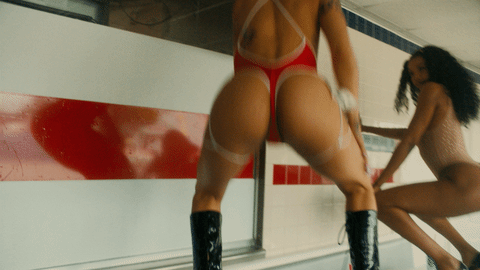Twerking, a dance move that involves shaking and gyrating the hips in a suggestive manner, has its origins in African and Caribbean dance traditions. The dance move can be traced back to traditional African dances such as the Mapouka from the Ivory Coast and the Kpanlogo from Ghana, both of which involve rhythmic hip movements. These dances were brought to the Caribbean through the transatlantic slave trade and eventually evolved into the dance styles of dancehall and reggae, where twerking as we know it today began to take shape.
In the Caribbean, twerking became popular in dancehall and reggae music videos, where dancers would showcase their skills in a highly sexualized manner. The dance move was often used as a form of expression and empowerment for women, as it allowed them to assert their sexuality and take ownership of their bodies. Twerking also became a way for people to celebrate their cultural heritage and connect with their African and Caribbean roots through dance. As the dance move gained popularity in the Caribbean, it eventually made its way to the United States, where it would become a staple in hip-hop and rap music videos.
Twerking in the 90s: How it Emerged in Hip-Hop and Rap Music Videos
In the 1990s, twerking emerged as a prominent dance move in hip-hop and rap music videos, where it became synonymous with the genre’s hypersexualized imagery. Artists such as 2 Live Crew, Missy Elliott, and Juvenile featured twerking dancers in their music videos, further popularizing the dance move and cementing its place in popular culture. Twerking became a symbol of empowerment and self-expression for many women in the hip-hop community, as it allowed them to assert their sexuality and challenge traditional gender norms.
The 90s also saw the rise of twerking as a form of protest and resistance, as it was often used by marginalized communities to reclaim their bodies and challenge societal expectations. Twerking became a way for people to express their identity and celebrate their cultural heritage, as it allowed them to connect with their African and Caribbean roots through dance. The dance move also became a way for people to challenge the status quo and push back against societal norms, as it allowed them to assert their agency and take ownership of their bodies. Twerking in the 90s was a powerful form of self-expression and empowerment, as it allowed people to celebrate their bodies and embrace their sexuality in a way that was both liberating and empowering.

The 2000s: Twerking Goes Mainstream with Pop Culture and Social Media
The 2000s saw twerking go mainstream, as it became a popular dance move in pop culture and social media. Artists such as Beyoncé, Rihanna, and Miley Cyrus incorporated twerking into their performances and music videos, further popularizing the dance move and bringing it to a wider audience. Twerking became a symbol of empowerment and self-expression for many women in the mainstream music industry, as it allowed them to assert their sexuality and challenge traditional gender norms.
Social media also played a significant role in the mainstreaming of twerking, as platforms such as YouTube and Vine allowed people to share videos of themselves twerking with a global audience. Twerking videos went viral, with people from all walks of life showcasing their twerking skills and celebrating their bodies through dance. Twerking became a global phenomenon, as people from around the world embraced the dance move and made it their own. The 2000s marked a turning point for twerking, as it transitioned from an underground dance move to a mainstream pop culture phenomenon that was embraced by people of all ages and backgrounds.
Twerking in the 2010s: The Rise of Twerking as a Global Phenomenon
The 2010s saw the rise of twerking as a global phenomenon, as the dance move became a staple in music videos, live performances, and social media. Artists such as Nicki Minaj, Cardi B, and Megan Thee Stallion incorporated twerking into their music and performances, further popularizing the dance move and solidifying its place in popular culture. Twerking became a symbol of empowerment and self-expression for many women in the music industry, as it allowed them to assert their sexuality and challenge traditional gender norms.
The 2010s also saw the rise of twerking as a form of protest and resistance, as it was often used by marginalized communities to reclaim their bodies and challenge societal expectations. Twerking became a way for people to express their identity and celebrate their cultural heritage, as it allowed them to connect with their African and Caribbean roots through dance. The dance move also became a way for people to challenge the status quo and push back against societal norms, as it allowed them to assert their agency and take ownership of their bodies. Twerking in the 2010s was a powerful form of self-expression and empowerment, as it allowed people to celebrate their bodies and embrace their sexuality in a way that was both liberating and empowering.

The Evolution of Twerking: From Underground Dance to Mainstream Pop Culture
The evolution of twerking from an underground dance to a mainstream pop culture phenomenon has been a remarkable journey that has spanned decades. What began as a traditional African and Caribbean dance move has evolved into a global dance phenomenon that has transcended cultural boundaries and become a symbol of empowerment and self-expression for people around the world. Twerking has become a way for people to celebrate their bodies and embrace their sexuality, as it allows them to assert their agency and challenge societal expectations.
The evolution of twerking has also been marked by its ability to adapt and change with the times, as the dance move has continued to evolve and take on new forms. From its origins in African and Caribbean dance traditions to its mainstream popularity in hip-hop and rap music videos, twerking has continued to reinvent itself and remain relevant in popular culture. The dance move has also become a symbol of resistance and protest, as it has been used by marginalized communities to challenge societal norms and reclaim their bodies. Twerking has evolved from a dance move to a cultural phenomenon that has had a lasting impact on popular culture and society as a whole.
Twerking in the Digital Age: How Social Media Platforms Have Influenced its Spread
The digital age has played a significant role in the spread of twerking, as social media platforms have allowed people to share videos of themselves twerking with a global audience. Platforms such as Instagram, TikTok, and YouTube have made it easier than ever for people to showcase their twerking skills and connect with others who share their love for the dance move. Twerking videos have gone viral, with people from all walks of life embracing the dance move and making it their own.
Social media has also allowed twerking to become a global phenomenon, as people from around the world have been able to connect with each other and share their love for the dance move. Twerking has become a way for people to express themselves and celebrate their bodies, as it allows them to assert their agency and challenge societal expectations. The digital age has allowed twerking to reach new heights of popularity and become a symbol of empowerment and self-expression for people of all ages and backgrounds.
Twerking in Music Videos: A Look at the Impact of Twerking on Music and Entertainment
Twerking has had a significant impact on music and entertainment, as the dance move has become a staple in music videos and live performances. Artists such as Beyoncé, Rihanna, and Nicki Minaj have incorporated twerking into their music and performances, further popularizing the dance move and solidifying its place in popular culture. Twerking has become a symbol of empowerment and self-expression for many women in the music industry, as it allows them to assert their sexuality and challenge traditional gender norms.
Twerking has also had a lasting impact on entertainment, as the dance move has become a popular form of expression and celebration for people around the world. Twerking has become a way for people to connect with their African and Caribbean roots through dance, as it allows them to celebrate their cultural heritage and express their identity. The impact of twerking on music and entertainment has been profound, as the dance move has become a global phenomenon that has transcended cultural boundaries and become a symbol of empowerment and self-expression for people of all ages and backgrounds.
Twerking in the 21st Century: How the Dance Trend Continues to Evolve and Change
In the 21st century, twerking has continued to evolve and change, as the dance trend has taken on new forms and adapted to the times. From its origins in African and Caribbean dance traditions to its mainstream popularity in hip-hop and rap music videos, twerking has continued to reinvent itself and remain relevant in popular culture. The dance move has also become a symbol of resistance and protest, as it has been used by marginalized communities to challenge societal norms and reclaim their bodies.
Twerking in the 21st century has also become a global phenomenon, as the dance move has transcended cultural boundaries and become a symbol of empowerment and self-expression for people around the world. Twerking has become a way for people to celebrate their bodies and embrace their sexuality, as it allows them to assert their agency and challenge societal expectations. The 21st century has seen twerking continue to evolve and change, as the dance trend has remained a powerful form of self-expression and empowerment for people of all ages and backgrounds.
Twerking in the Age of Feminism: Exploring the Empowerment and Controversy Surrounding Twerking
Twerking has been a source of empowerment and controversy in the age of feminism, as the dance move has been both celebrated and criticized for its sexualized nature. Twerking has become a symbol of empowerment for many women, as it allows them to assert their sexuality and challenge traditional gender norms. The dance move has also been a way for people to celebrate their bodies and embrace their sexuality, as it allows them to assert their agency and take ownership of their bodies.
However, twerking has also been the subject of controversy, as it has been criticized for its sexualized nature and its impact on societal expectations. Some have argued that twerking perpetuates harmful stereotypes and objectifies women, while others have defended it as a form of self-expression and empowerment. Twerking has sparked important conversations about feminism and the representation of women in popular culture, as it has forced people to confront their own biases and assumptions about gender and sexuality. Twerking in the age of feminism has been a complex and nuanced issue, as it has both empowered and challenged societal norms in equal measure.
The Future of Twerking: Predictions for How the Dance Trend Will Continue to Evolve in the Coming Decades
As twerking continues to evolve and change, it is likely that the dance trend will continue to have a lasting impact on popular culture and society as a whole. Twerking has become a global phenomenon that has transcended cultural boundaries and become a symbol of empowerment and self-expression for people of all ages and backgrounds. The dance move has also become a way for people to celebrate their bodies and embrace their sexuality, as it allows them to assert their agency and challenge societal expectations.
In the coming decades, it is likely that twerking will continue to evolve and take on new forms, as the dance trend has proven to be adaptable and resilient. Twerking has the potential to continue to challenge societal norms and push back against traditional gender expectations, as it has become a powerful form of self-expression and empowerment for people around the world. The future of twerking is bright, as the dance trend shows no signs of slowing down and continues to have a lasting impact on popular culture and society as a whole.

